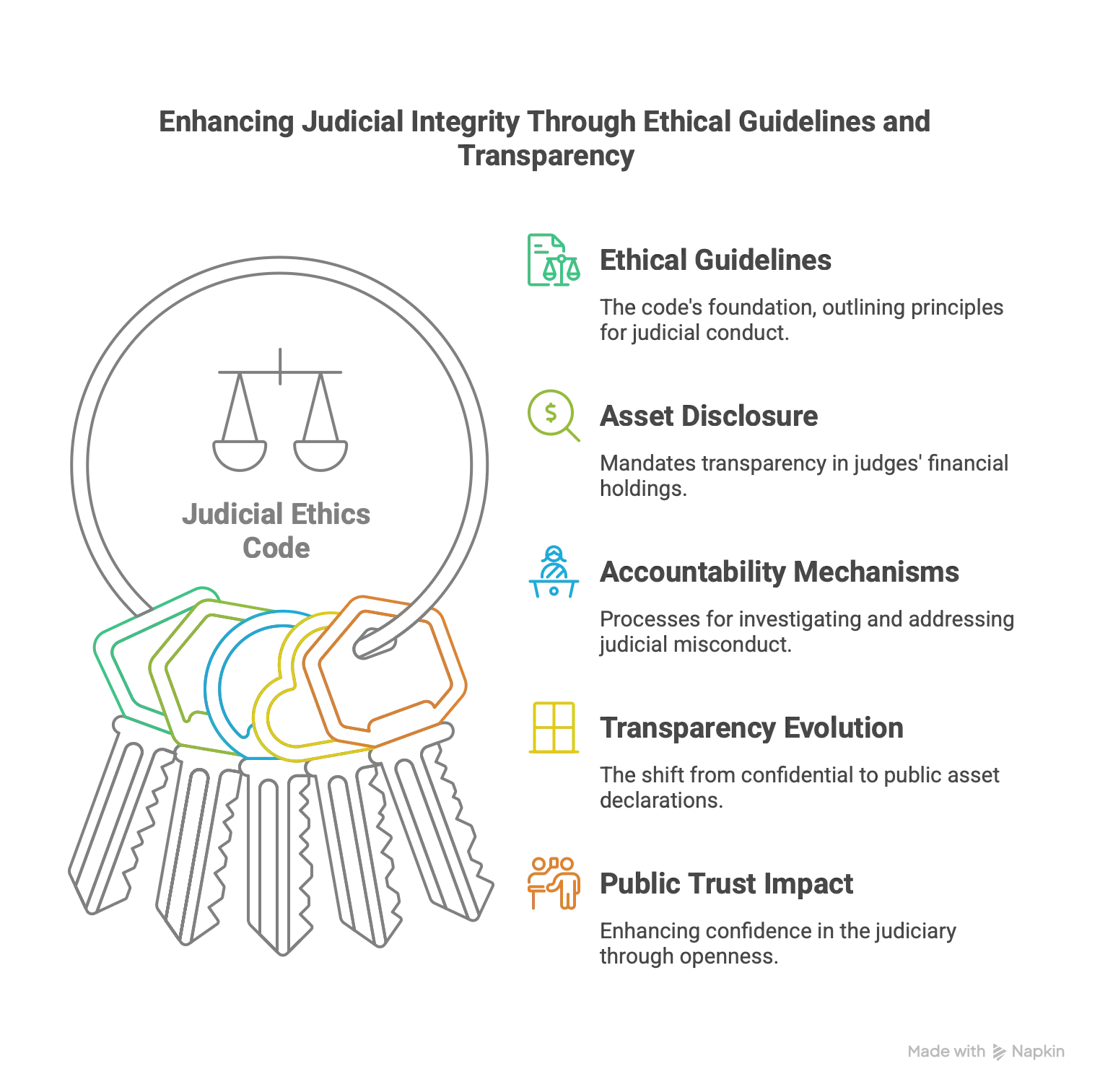UPSC
Indian Express Concise
Judicial Transparency and Accountability: The 1997 Ethics Code and Beyond
Last Updated
6th April, 2025
Date Published
6th April, 2025
Share This Post With Someone

Judicial transparency and accountability are critical pillars of a robust democracy, ensuring public trust in the judiciary. The Supreme Court’s recent decision to mandate public disclosure of judges’ assets revisits the 1997 Restatement of Values of Judicial Life, offering insights into evolving judicial ethics and institutional accountability mechanisms in India. This summary provides key points from the development, relevant for aspirants preparing for competitive examinations.

Key Points:
- 1997 Ethics Code Adoption: On May 7, 1997, the Supreme Court (SC) adopted the "Restatement of Values of Judicial Life" during a full court meeting chaired by then Chief Justice J.S. Verma, establishing a code of ethics for judges.
- Asset Declaration Mandate: The 1997 resolution required all judges to declare assets (real estate and investments) held by themselves, their spouses, or dependents to the Chief Justice of India (CJI) within a reasonable time of assuming office.
- Confidentiality Clause: Initially, these declarations were to remain confidential, submitted only to the CJI, not for public disclosure.
- Shift to Voluntary Disclosure: In 2009, following a full court meeting, SC judges decided to declare their assets publicly on a voluntary basis, marking a shift from the 1997 stance.
- RTI and Judicial Assets: A 2018 Constitution Bench ruling clarified that judges’ assets and liabilities are not "personal information" under the Right to Information (RTI) Act, making them subject to public disclosure requests.
- April 2025 Decision: On April 1, 2025, a full court meeting resolved that SC judges must publicly declare their assets, reinforcing the 1997 ethics code and ending the voluntary disclosure practice.
- Purpose of the Code: The 1997 code aimed to create a framework for institutional accountability, addressing judicial conduct, asset declarations, and inquiries into allegations of misbehavior or corruption.
- In-House Inquiry Mechanism: The code laid the groundwork for an "in-house procedure" to investigate judges accused of breaching these values, avoiding the higher bar of impeachment.
- Recent Inquiry Example: In March 2025, CJI Sanjiv Khanna initiated an in-house inquiry against Justice Yashwant Varma, demonstrating the linkage between the 1997 resolution and inquiry processes.
- Judicial Accountability: The ethics code and inquiry process provide a method to address "bad conduct" (e.g., bias, petty corruption) that falls short of impeachment-worthy "proved misbehavior," as noted in a 1995 SC case on Bombay HC Chief Justice.
- 2014 Case Reference: The resolution was invoked in 2014 when an SC inquiry addressed a sexual harassment complaint by a Madhya Pradesh judge against a High Court judge, emphasizing remedial action for judicial misconduct.
- 16 Ethical Guidelines: The 1997 Restatement lists 16 non-exhaustive values, including:
- Upholding justice without fear or favor.
- Maintaining impartiality and avoiding bias.
- Refraining from political involvement or public comments on pending cases.
- Avoiding financial dealings that compromise independence.
- Ensuring personal conduct aligns with judicial dignity.
- Voluntary Disclosure Challenges: Post-2009, voluntary asset declarations were inconsistent; by 2018, the SC website ceased updates, reflecting reluctance among judges.
- Public Servants Comparison: Unlike judges, government officials and elected representatives are mandated to disclose assets publicly under the RTI Act and election laws, highlighting a transparency gap.
- Judicial Independence vs. Accountability: The 2025 decision balances judicial independence with public accountability, responding to calls for greater transparency in the judiciary.
- Impact on Public Trust: Mandatory disclosure aims to enhance litigants’ confidence in the judicial system, aligning with democratic principles of openness.
Glossary
- Restatement of Values of Judicial Life: A 1997 SC ethics code guiding judicial conduct.
- Asset Declaration: Statement of a judge’s real estate and investments.
- In-House Inquiry: Internal judicial process to investigate misconduct allegations.
- Judicial Accountability: Mechanisms to ensure judges adhere to ethical standards.
- Impeachment: Constitutional process to remove judges for proved misbehavior.
- RTI Act: Law enabling public access to information, including judicial assets.
- Full Court Meeting: Assembly of all SC judges to decide policy matters.
- Voluntary Disclosure: Optional public revelation of assets by judges.
- Confidentiality Clause: Rule keeping initial asset declarations private to the CJI.
- Bad Conduct: Actions inconsistent with judicial office, short of impeachment grounds.
Link To The Original Article – https://indianexpress.com/article/explained/explained-law/sc-judges-publicly-declare-assets-recalling-1997-ethics-code-9928564/